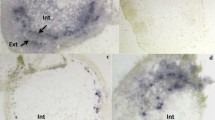Abstract
Nicandra physaloides, a common weed in South America, was found to be infected by an isolate of Tomato severe rugose virus (ToSRV), a bipartite begomovirus. The plants developed severe yellow rugose mosaic and were collected in São Paulo State, Brazil. This isolate of ToSRV was transmitted by Bemisia tabaci B biotype from infected plants of N. physaloides to healthy plants of N. physaloides and tomato in a glasshouse. This is the first report of natural infection of N. physaloides by ToSRV in Brazil.



Similar content being viewed by others
References
Agra MF, Rocha EA, Formiga SC, Locatelli EM (1994) Plantas medicinais dos Cariris Velhos, Paraíba. Parte I: subclasse Asterideae (in Portuguese). Rev Bras Farm 75:61–64
Altschul SF, Madden TL, Schäffer AA, Zhang J, Zhang Z, Miller W, Lipman DJ (1997) Gapped BLAST and PSI-BLAST: a new generation of protein database search program. Nucleic Acids Res 25:3389–3402
Bezerra-Agasie IC, Ferreira GB, Ávila AC, Inoue-Nagata AK (2006) First report of Tomato severe rugose virus in chilli pepper in Brazil. Plant Dis 90:114
Castillo-Urquiza GP, Beserra JEA Jr, Bruckner FP, Lima ATM, Varsani A, Alfenas-Zerbini P, Zerbini FM (2008) Six novel begomoviruses infecting tomato and associated weeds in southeastern Brazil. Arch Virol 153:1985–1989
Dellaporta SL, Wood J, Hicks JB (1983) A plant DNA minipreparation: Version II. Plant Mol Biol Rep 1:19–21
Fauquet CM, Briddon RW, Brown JK, Moriones E, Stanley J, Zerbini M, Zhou X (2008) Geminivirus strain demarcation and nomenclature. Arch Virol 153:783–821
Fernandes JJ, Carvalho MG, Andrade EC, Brommonschenkel SH, Fontes EPB, Zerbini FM (2006) Biological and molecular properties of Tomato rugose mosaic virus (ToRMV), a new tomato-infecting begomovirus from Brazil. Plant Pathol 55:513–522
Fernandes FR, Albuquerque LC, Giordano LB, Boiteux LS, Ávila AC, Inoue-Nagata AK (2008) Diversity and prevalence of Brazilian bipartite begomovirus species associated to tomatoes. Virus Genes 36:251–258
Inoue-Nagata AK, Ribeiro SG, Rocha WB, Albuquerque LC, Ávila AC, Giordano LB (2003) A new begomovirus isolated from Nicandra physaloides. Virus Rev Res 116:186
Inoue-Nagata AK, Albuquerque LC, Rocha WB, Nagata T (2004) A simple method for cloning the complete begomovirus genome using the bacteriophage phi 29 DNA polymerase. J Virol Methods 116:209–211
Kurozawa C, Pavan MA (2005) Doenças do Tomateiro. In: Kimati H, Amorin L, Rezende JAM, Bergamin Filhjo A, Camargo LEA (eds) Manual de Fitopatologia - Doenças da Plantas Cultivadas (in Portuguese). Editora Agronômica Ceres Ltda, São Paulo, pp 607–626
Rojas MR, Gilbertson RL, Russell DR, Maxwell DP (1993) Use of degenerate primers in the polymerase chain reaction to detect whitefly-transmitted geminiviruses. Plant Dis 77:340–347
Sambrook J, Fritsch EF, Maniatis T (eds) (1989) Molecular cloning: a laboratory manual, 2nd edn. Cold Spring Harbor Press, New York
Souza-Dias JAC, Sawazaki HE, Pernambuco-Fo PCA, Elias LM, Maluf H (2008) Tomato severe rugose virus: another begomovirus causing leaf deformation and mosaic symptoms on potato in Brazil. Plant Dis 92:487
Staden R (1996) Indexing and using sequence databases. Methods Enzymol 266:105–114
Stanley J, Bisaro DM, Briddon RW, Brown JK, Fauquet CM, Harrison BD, Rybicki EP, Stenger DC (2005) Family Geminiviridae. In: Fauquet CM, Mayo MA, Maniloff J, Desselberger U, Ball LA (eds) Virus taxonomy. Eighth Report of the International Committee on Taxonomy of Viruses. Elsevier-Academic Press, San Diego, pp 301–326
Tamura K, Dudley J, Nei M, Kumar S (2007) MEGA4: Molecular evolutionary genetics analysis (MEGA) software version 4.0. Mol Biol Evol 24:1596–1599
Thompson JD, Higgins DG, Gibson TJ (1994) CLUSTAL_W: improving the sensitivity of progressive multiple sequence alignment through sequence weighting, position-specific gap penalties and weight matrix choice. Nucleic Acids Res 22:4673–4680
Author information
Authors and Affiliations
Corresponding author
Rights and permissions
About this article
Cite this article
Barbosa, J.C., Barreto, S.S., Inoue-Nagata, A.K. et al. Natural infection of Nicandra physaloides by Tomato severe rugose virus in Brazil. J Gen Plant Pathol 75, 440–443 (2009). https://doi.org/10.1007/s10327-009-0198-5
Received:
Accepted:
Published:
Issue Date:
DOI: https://doi.org/10.1007/s10327-009-0198-5




